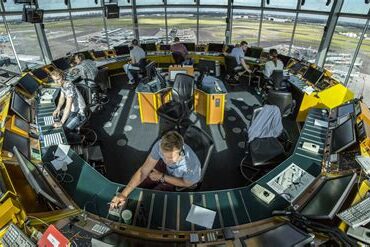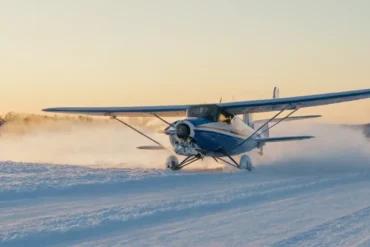Hey there, new pilots! Feeling a bit nervous about talking to air traffic control? Don’t worry, we’ve got your back with this handy guide.
Let’s face it, chatting with ATC can seem pretty scary at first. But trust me, with a little practice, you’ll be a pro in no time and feel totally at ease.
Memorizing all those radio calls might make your head spin. But here’s the good news: once you get the hang of a few key phrases, you’ll be zipping through controlled airspace like it’s no big deal.
Your flight instructor will be your wingman (pun intended) as you learn these important communication tricks during your pilot training.
If you’re lucky enough to train at an airport with a control tower, you’ll get plenty of chances to practice your radio skills and get comfy talking to the tower folks.
Training at an uncontrolled airport? No sweat! You’ll use the common traffic advisory frequency, but you might want to squeeze in some extra practice with your instructor. It’s a great idea to fly to a few controlled airports to get some real-world experience under your belt.
Now, let’s dive into 10 must-know ATC phrases and how to use them when you’re chatting with the folks up in the tower.
WILCO
Ever heard “Wilco” on the radio? It’s not just a cool indie band – it’s short for “Will Comply.” When you say “Wilco,” you’re telling ATC, “Got it, and I’ll do exactly what you said.”
But here’s a pro tip: even when you use “Wilco,” it’s smart to repeat back what ATC told you. That way, everyone’s on the same page and there’s no room for mix-ups.
Roger
“Roger” is like the Swiss Army knife of pilot responses. It’s a quick way to say, “Yep, I heard what you said.” But watch out – don’t use it for yes or no questions. For those, stick with “Affirmative” or “Negative.”
Traffic Calls
ATC uses a cool trick to let you know where other planes are: they use clock positions. Imagine your plane is at the center of a giant clock face. Straight ahead is 12 o’clock, directly behind you is 6 o’clock, and so on.
Keep in mind, when ATC gives you these positions, they’re based on where you’re going on the ground, not accounting for any wind adjustments you might be making.
A typical call might sound like this: “N31468, heads up, you’ve got traffic at 2 o’clock, 4 miles away, heading the opposite direction, same altitude as you.”
Your job is to keep an eye out and respond appropriately. If you spot the plane they’re talking about, just say “Traffic in sight.” But remember, only say this if you actually see the plane with your own eyes, not just on your instruments.
Can’t find the traffic? No worries, just say “Negative contact.” This lets ATC know you need some extra help avoiding that plane.
Line Up and Wait
Sometimes, the tower needs things to move quickly. If they tell you to “Line Up and Wait,” they want you to taxi onto the runway but hold your horses – don’t take off yet! You’re just getting in position for a quick departure once they give you the all-clear.
This often happens when another plane has just landed and needs a moment to clear the runway. It’s like being in the on-deck circle in baseball – you’re next up, but you’re not swinging yet.
Landing Sequence
At busy airports, ATC juggles a lot of planes at once. They might line up several planes to land one after another, like a well-choreographed dance.
You might hear something like, “N31468, you’re cleared to land on runway one eight, and you’re third in line.”
This means two other planes will touch down before you do. It’s super important to stay aware of what’s happening around you, knowing where those other planes are and where you fit into the landing conga line.
A Proper Takeoff Call
After you’ve done your pre-flight checks, it’s time to let the tower know you’re ready to rock and roll. Be clear about who you are, where you are, and what you want to do.
Try something like this: “Addison Tower, Skyhawk N31468 here, holding short of runway 16 on Alpha. We’re looking for a VFR departure to the east, please.”
The tower will then give you further instructions or acknowledge your request. They might clear you for takeoff, tell you to line up and wait, or let you know where you are in the departure queue.
Always repeat back any instructions you get – it’s like double-checking your grocery list to make sure you didn’t forget anything.
Exit the Runway
After you land, things can get a bit tricky. You might be told to “Exit the Runway” at a specific spot. If it’s safe, aim for that exit. If not, no worries – just take the next safe exit.
You might hear different instructions about what to do next. If they say “Contact Ground,” that means fully exit the runway, stop, switch to the ground frequency, and let them know where you are and where you want to go.
If they say “Monitor Ground,” they’ll probably give you taxi instructions right away. Just switch to the ground frequency after you exit, but you don’t need to check in – they’ll call you if they need you.
Sometimes you’ll hear “Stay with me.” This usually happens when it’s not too busy or when one controller is handling everything. It just means stay on the tower frequency while you taxi.
One last tip: when controllers mention ground control frequencies, they often just say the last few numbers. So “ground point 6” means 121.6.
Resume Own Nav
When ATC says “Resume Own Nav,” they’re basically saying, “You’re on your own now, buddy!” It means they’re no longer telling you where to go – it’s up to you to navigate to your destination or next cleared location.
Hold Short
When you’re moving around on the ground, you might hear “Hold Short” of a certain spot, like a runway or taxiway. For example, “N31468, taxi to runway 13 via Alpha, hold short taxiway Charlie for opposite direction traffic.”
This means stop before you get to taxiway Charlie on Alpha. Don’t go past that point until ATC gives you the green light.
Squawk VFR
When the tower is done guiding you, they might tell you to “Squawk VFR.” This means set your transponder to 1200. It’s like putting up a sign that says, “I’m flying by Visual Flight Rules now, and I’m not getting any special services.”
Talking to ATC with Confidence
These phrases are super important for staying safe when you’re flying in controlled airspace. But there’s plenty more to learn!
Chat with your instructor and check out resources like the “Pilot/Controller Glossary” (you can find it online or in most FAR/AIMs). The more you study, the more comfortable you’ll feel on the radio. Before you know it, you’ll be chatting with ATC like a pro!


















